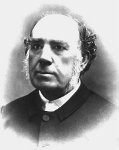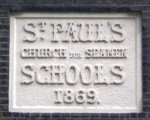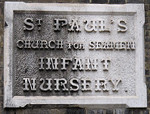
Daniel Greatorex (1829-1901)
 Dan Greatorex studied for ordination at St Bees'
College
in Cumbria for two years, from 1854. So he was the first non-Oxbridge
incumbent in the area. As a non-graduate, in 1876 the Archbishop of Canterbury conferred on him a Bachelor of
Divinity degree, and thereafter he always added the letters 'B.D.'
after his name, including in baptism and wedding registers. (Not to be
outdone, his curates started to do the same!) He served his title as
curate of St Mary Bilston, in
Lichfield diocese, before moving to London as Chaplain to the Thames
Church Mission. It was here that he began his scheme of ships lending
libraries.
Dan Greatorex studied for ordination at St Bees'
College
in Cumbria for two years, from 1854. So he was the first non-Oxbridge
incumbent in the area. As a non-graduate, in 1876 the Archbishop of Canterbury conferred on him a Bachelor of
Divinity degree, and thereafter he always added the letters 'B.D.'
after his name, including in baptism and wedding registers. (Not to be
outdone, his curates started to do the same!) He served his title as
curate of St Mary Bilston, in
Lichfield diocese, before moving to London as Chaplain to the Thames
Church Mission. It was here that he began his scheme of ships lending
libraries.
| In
addition to this
great
metropolis, there is scarcely a large town in the kingdom but has
adopted 'Poor Children's Dinners', but few people are aware that the
idea originated with myself. The first dinners provided for Poor
Children were given at no.12, Wellclose Square, where the Schools were
then held. The establishing of 'Poor Children's Dinners' must ever be
connected with St Paul's Schools. More than ten years elapsed before
any other School took the matter up. It is only justice to myself, and
to those benevolent friends who so ably assisted me, that this fact
should be known. A movement is being made by some enthusiastic people to establish 'Self-Supporting Penny Dinners', but such Dinners are of little or no benefit to the children. The food is too poor for the children's stomachs to digest – they become sick after partaking of it – and seldom try it more than two or three times. |
| The
idea of providing
boxes of books for the Merchant Seamen was put forth by a member of the
Society of Friends about the year 1854. He had small boxes made about
ten inches long, about six inches wide, and five inches deep. Each box
held about ten small volumes. In 1859 I commenced on a larger scale, but it was not till 1864 that the plan of providing ships with Library Boxes was thoroughly carried out. I then completely organised a system which has now been adopted by nearly all the Missions to Seamen in England, America, and Canada. Each box contains about 25 volumes of carefully assorted books on history, travels, voyages, and biographies, and Prayer Book and Bible. The box is removed when the ship comes into dock, and another is placed on board a few days before she sails. These Libraries have proved of great value to the crews of the ships. The Seamen are able to obtain instruction, and pass away the time of a long voyage cheerfully and profitably. Few landsmen can realise the tediousness of a long voyage, with little to change the monotony, beyond the variation of the weather; consequently a good Library is a great boon. |
 1866
& 1867 -
Girls' & Boys' Schools opened on
the same
premises
1866
& 1867 -
Girls' & Boys' Schools opened on
the same
premises 
 Demand for school places was high, and they had become overcrowded, so
educational grants were at risk. In the event, the Bishop of London's
Fund bought the former Danish Church in Wellclose Square
for £2000. Surveys showed the walls were unsound, so
rather
than convert it, as originally planned, it was demolished and a new
school planned to designs by Dan's architect brother, Reuben
Courtnell Greatorex.
(Reuben lived at Upper Westbourne Terrace, Hyde Park, and was
the first family historian. On his death, he and his brother Simeon
were commemorated in the church with a simple tablet.)
Demand for school places was high, and they had become overcrowded, so
educational grants were at risk. In the event, the Bishop of London's
Fund bought the former Danish Church in Wellclose Square
for £2000. Surveys showed the walls were unsound, so
rather
than convert it, as originally planned, it was demolished and a new
school planned to designs by Dan's architect brother, Reuben
Courtnell Greatorex.
(Reuben lived at Upper Westbourne Terrace, Hyde Park, and was
the first family historian. On his death, he and his brother Simeon
were commemorated in the church with a simple tablet.)|
St Paul's Vicarage
Febry
12th 1870 Dock Street London Docks E. Dear Sir, You will doubtless remember that in the year 1864 Your Society kindly made me a Grant to commence a School in this District, containing a population of 9668 persons, which up to this time had had no provision whatever made for the Education of the children of so great a mass. I commenced by establishing an Infant School in a single room on a first floor. In June of the following Year I took a house at N°12 Wellclose Square, at a rent of £52.10.0 per annum and removed the Infant School thereto. In 1866 you again very kindly made me a Grant by means of which I was enabled to commence a Girls' School, and in the month of November 1867 once more, by the help of your excellent Society, I was enabled to open a Boys' School. These Schools were soon filled to their utmost capacity with children, there being at the present time nearly 500 children on the Books. My Committee therefore felt that it was most important that other and more suitable accommodation should be provided. In Febry 1868 the Committee of the Bishop of London's Fund purchased the Site of the old Danish Chapel in Wellclose Square for £2000, and conveyed it to myself andf Churchwardens for the time being, for the purpose of erecting the Buildings so urgently needed. Plans for the new Buildings were submitted to and approved by the Committee of the Council of Education. The lowest of 9 Tenders was accepted and a Contract entered into for the Carcase £3440 and the Finishings £1450, making a Total of £4890. It was felt at the time the plans were being prepared that provision should be made for Residences for the Master and Mistresses, and also for a Recreation Ground where the children might play at all times, instead of amusing themselves in the Street (as they do at present) surrounded by vice and profligacy of the worst possible character. The Buildings will therefore provide, First, Schools for an average of 600 children, viz 150 Boys, 150 Girls, 300 Infants. Second, Two dwelling houses for the Master and Mistresses. Third, A large covered playground. The Committee having accepted the first part of the Contract and the Building now being roofed in, as the Schools have become an absolute necessity, the Committee feel that the second part of the contract should be proceeded with and the Building be opened in May next if possible. The Sum of £2490 has already been secured, in addition to which the Privy Council has made a Grant of £761.13.9 which will be paid when the Building is completed. You will be glad to learn that after most strenuous exertions the Annual Income is nearly provided for, as you will see by the enclosed Balance Sheet, there being a deficiency of only £8.8.1. When the New Buildings are occupied the expenses will be less by the amount of rent paid for the present house. The Teaching Staff consists of Master, 2 Mistresses and 4 Pupil Teachers and 5 Monitors, all certificated by the Committee of Council on Education, the Schools at the last examination being much commended by Her Majesty's Inspector. I trust therefore that Your Committee will kindly give these statements their best consideration and also the fact of the extreme poverty of the neighbourhood, and will add to their past kindness, by giving me their most liberal aid to assist me in my endeavours to extend the blessings of education to these poor and hitherto neglected children, and so complete the Great Work which Your Society initiated. Believe me Very faithfully yours Dan Greatorex Vicar of St Paul's Whitechapel |
 1874 Infant Nursery & Mission Room, Wellclose Square
1874 Infant Nursery & Mission Room, Wellclose Square

 On
the first floor were kitchens and a day nursery for babies and
children. On its first day a single child was brought, but within a few
weeks it was at capacity, with 50 to 60 infants. Some of the Clothed
Scholars were trained to help. An honorary surgeon, Joseph Lane, was in
attendance.
On
the first floor were kitchens and a day nursery for babies and
children. On its first day a single child was brought, but within a few
weeks it was at capacity, with 50 to 60 infants. Some of the Clothed
Scholars were trained to help. An honorary surgeon, Joseph Lane, was in
attendance. | This pretty little cottage hospital is in the same building as the Infant Nursery, and has been formed by making three rooms in the roof. The cost was provided by Mrs Graham, of Malta. It holds five beds, and when funds are received another bed will be added. The cases which are received are such that would not be taken into a general hospital, yet require hospital care and treatment. Few can realise how sad it is for a child to be sick at home, and to be left by itself all day in bed, as the mother is obliged to go out and earn her daily living; hence this little Hospital has proved a great boon to children and parents. |
| The Rev. Dan Greatorex said the local authorities had no power whatever over the police, and it was the duty of those who were responsible - the Home Secretary and Sir Charles Warren - to say whether they had sufficient force to ensure peace and order, and if not to ask for more. Whitechapel was becoming notorious all over the world as a place to be shunned and feared, and if the suspicion once gains a hold that it is unsafe for a woman to be in Whitechapel streets after nightfall, the result must be utter ruin of all trade. The public should insist that the responsible officials should take every human means to prevent these awful tragedies and remove the suspicion which existed that there was inefficient management. For one thing he regretted the frequent changes of police divisions which was now the custom. If a neighbourhood was to be properly guarded the constables should be kept permanently in charge of it, so that they might become acquainted with every hole and corner of it, and know by sight almost every person in it. The new system made this impossible, and it was now breaking down. |
|
|
Greatorex presented the bulk of his collection to the Whitechapel Free Library shortly after it opened to the public in 1891 – a gesture of his life-long interest in the local population’s education. The Whitechapel commissioners deemed it worthy of a whole room and it became the nucleus of a new museum on the second floor. According to Percy Horne, the museum’s interwar curator, Greatorex’s most bizarre donations were clubs, axes and spears furnished with shark’s teeth belonging to 'cannibals and headhunters' of the South Pacific Islands and New Guinea. Dating back to the 1870’s, many had seen active service, particularly those which belonged to bloodthirsty king Thacomba of Fiji. Amongst the weapons were other South Pacific specimens like a 'beautifully carved' paddle from Mangaia, the most southerly of the Cook Islands. A contemporary donation book (c.1891 – 1908) details a menagerie of natural history specimens also received from Greatorex, who was enchanted by the creatures he met on his travels. Fifteen species of dry snake, an Amazonian salamander and turtle carapaces jostled for space in dark cabinets with assorted marine life, including squids, the jaws of a great white shark and some remoras, which, in life, would have dined on their neighbour’s parasites. The remains of his pet - presented to him by two children on Ascension Island – must have been among the turtle specimens. On 25 March 1873 he wrote I gave them (the children) a shilling, but the poor fellows said there was nothing money could buy on the island, neither sweetmeats nor toys. The amateur naturalist also ensnared one of the squids himself en route to Australia. According to a 12 October 1872 diary entry he kept a ‘Portuguese man-of-war’ in his sponge bath aboard the Saint Vincent for observation. The next paragraph reports a strong stinging sensation, and the squid is never heard from again. On the same trip, he bought aboriginal shields, a chopper and three wimmera spears for his collection, after hearing that a certain ‘Bullocky’ could hurl his spear 27 yards. (Incidentally, Bullocky was part of an all-aboriginal cricket team, which toured England in 1862 – the first overseas Australians to play in the country. One of their number died of tuberculosis and was buried in a pauper’s grave.) A man of his time, Greatorex said his own spear-throwing attempt amused the darkies no end. The Whitechapel museum grew under the regime of successive curators, but the catalogue remained scattershot at best. Apart the natural history specimens and Percy Horne’s mention of the South pacific weapons, the museum records are silent on the particulars of Dan Greatorex’s donation. However, the closure of the museum in 1953 (for lack of funding) left another intriguing clue. When the collection was divided up, some Egyptological specimens and a Rajputana sculptural figure found their way into the Horniman museum, accompanied by a single note asking: Who was Greatorex? Sadly, the curator is as yet unable to locate the artefacts or give further descriptions of them. |
 In his last months, in March 1897, Dan Greatorex opposed a scheme to restore part of his parish to St Botolph Aldgate. His
ministry came to a sudden end when he suffered a stroke, and he
resigned in 1897 (through
overwork and paralysis, according to the simple memorial
tablet in the church, left). He moved to 21 Castle Street, Dover, and married
the
spirited Margaret Doyle, whom
he had known for many years, for she had
been a Clothed Scholar and pupil at the school, then a teacher, and
finally Headmistress of the Infant School. There are many references to
Margaret, both positive and negative, in the school log.
Both as a pupil and as a teacher, she was often reprimanded and warned
about her conduct, but was also praised for good work and dedicated
teaching.
In his last months, in March 1897, Dan Greatorex opposed a scheme to restore part of his parish to St Botolph Aldgate. His
ministry came to a sudden end when he suffered a stroke, and he
resigned in 1897 (through
overwork and paralysis, according to the simple memorial
tablet in the church, left). He moved to 21 Castle Street, Dover, and married
the
spirited Margaret Doyle, whom
he had known for many years, for she had
been a Clothed Scholar and pupil at the school, then a teacher, and
finally Headmistress of the Infant School. There are many references to
Margaret, both positive and negative, in the school log.
Both as a pupil and as a teacher, she was often reprimanded and warned
about her conduct, but was also praised for good work and dedicated
teaching.  Dan
Greatorex died in Dover four years later, aged 72.
There is an irony to one of his last acts at St Paul's. As he was
leaving, he gave a collection of rare bibles
to St John's College,
Winnipeg - an Anglican college which became part of the University of
Manitoba. One of these contained a slip declaring that it was a first
edition of the 1611 King James Bible (its frontispiece was missing).
Recent
investigations
have shown
that it was from the very first
printing of 50 copies, as it contains a number of small errors which
were later corrected, and therefore very valuable. It would not perhaps
have fetched a huge sum in his own day, but had this been known then,
it might have saved him from some of the constant frenzy of
fundraising.
Dan
Greatorex died in Dover four years later, aged 72.
There is an irony to one of his last acts at St Paul's. As he was
leaving, he gave a collection of rare bibles
to St John's College,
Winnipeg - an Anglican college which became part of the University of
Manitoba. One of these contained a slip declaring that it was a first
edition of the 1611 King James Bible (its frontispiece was missing).
Recent
investigations
have shown
that it was from the very first
printing of 50 copies, as it contains a number of small errors which
were later corrected, and therefore very valuable. It would not perhaps
have fetched a huge sum in his own day, but had this been known then,
it might have saved him from some of the constant frenzy of
fundraising.